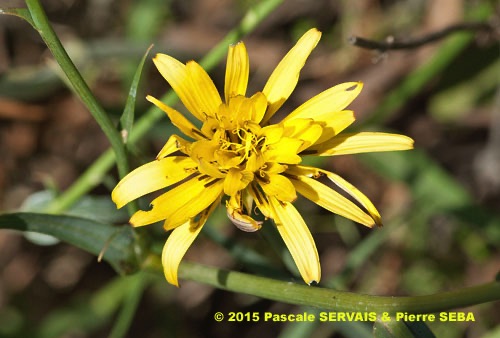
Scorzonera elata Boiss.
Fam. : Asteraceae
© Pascale SERVAIS & Pierre SEBA, 2018. Tilo Botanica: Flore de Tilos et du Dodécanèse / Flora of Tilos and of the Dodecanese
English translation by Brenda Bradbury, Howard Bradbury and Stéphane Léonard
Plante herbacée, hermaphrodite, érigée, à tiges feuillées, glabres, de 3 à 8 mm de diamètre, ramifiées, cylindriques, striées, sécrétant un latex quand on les coupe.
Feuilles à la base et alternes, simples, linéaires, entières, sessiles, embrassantes, effilées, un peu en gouttière, à bord rougeâtre, de 5 à 30 cm de long, de 3 à 12 mm de large, avec une nervure centrale marquée et 1 ligne blanchâtre au-dessus.
Fleurs jaune vif, souvent veinées de rouge dessous, réunies en capitules solitaires de 20 à 40 mm de diamètre, portés par un pédoncule s’allongeant à la fructification. Fleurons tous ligulés, terminés par 5 petites dents, nettement plus longs que l’involucre. Style noirâtre à brunâtre terminé par 2 stigmates jaunes en forme de double crosse. Involucre à bractées s’allongeant à la fructification, pointues, glabres, disposées sur 3 rangs, les internes beaucoup plus longues que les externes qui sont triangulaires. Ovaire infère.
Fruits, akènes glabres, de 10 à 12 mm de long (sans le pappus), brun clair, cylindriques, striés longitudinalement et parfois verruqueux, réunis en têtes de 45 à 50 mm de diamètre. Akènes portés par un minuscule pied noir (± 1 mm de long). Aigrette blanche à poils plumeux, de 7 à 8 mm de long, dépassée par 5 ou 6 arêtes blanches non plumeuses.
___________________________
Plant herbaceous, hermaphrodite, erect. Stems leafy, glabrous, from 3 to 8 mm in diameter, branched, cylindrical, striated, releasing a latex when cut.
Leaves at the base and alternate, simple, linear, entire, sessile, clasping, sharp, a little in gutter, with reddish edge, from 5 to 30 cm long, from 3 to 12 mm across, with a marked central vein and 1 whitish line above.
Flowers bright yellow, often with red veins below, joined together in solitary capitula from 20 to 40 mm in diameter, carried by a peduncle lengthening at fructification. Capitula with only ray-florets finished by 5 small teeth, definitely longer than involucre. Style blackish to brownish finished by 2 yellow stigmas in the shape of a double crosier. Involucre with bracts lengthening at fructification, pointed, glabrous, laid out on 3 rows, the internal ones much longer than the external ones which are triangular. Ovary inferior.
Fruits, glabrous achenes, from 10 to 12 mm long (without pappus), pale brown, cylindrical, longitudinally striated and sometimes verrucose, joined together in heads from 45 to 50 mm in diameter. Achenes carried by a tiny black foot (± 1 mm long). Pappus white with feathery hairs, from 7 to 8 mm long, exceeded by 5 or 6 nonfeathery white awns.
Descripteurs / Identifying features
1
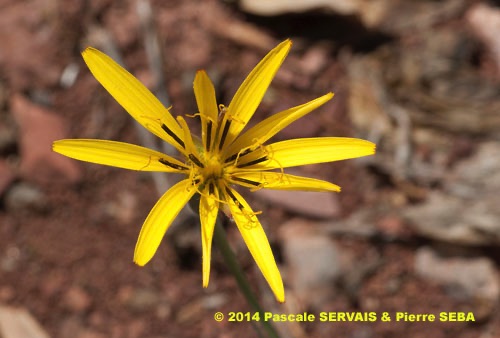
2
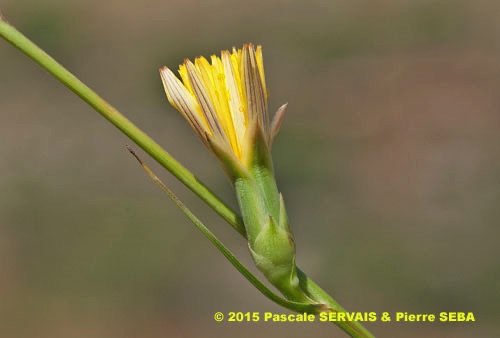
3
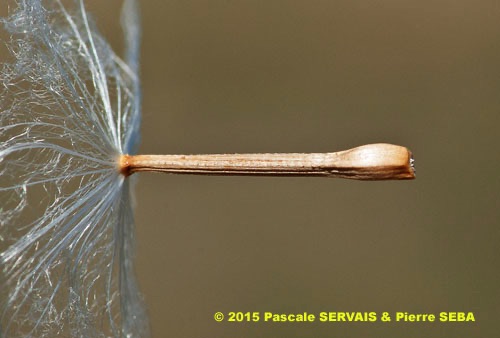
4
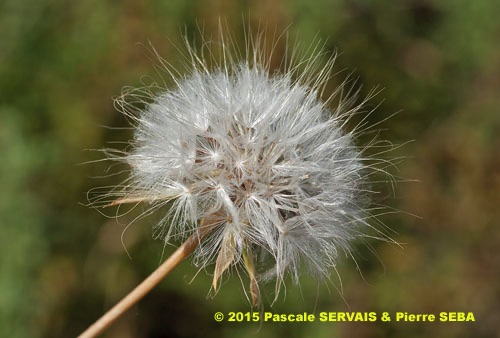
5
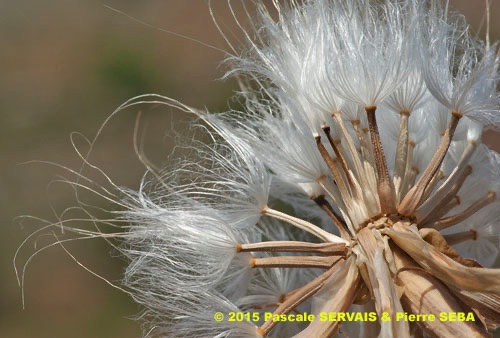
6

7
Étymologie / Etymology :
Scorzonera : emprunt de l’italien scorza (nom) = l’écorce + nera (adj.)
= noir, en référence à l’écorce noirâtre qui recouvre la racine.
OU
emprunt de l’ancien français scorzon (nom) = la vipère, en référence
à ses propriétés supposées d’antidote contre les morsures de serpent.
Elata : emprunt du latin elatus, -a, -um (adj.) = haut, élevé,
en référence à la hauteur de la plante.
Scorzonera : borrowed from Italian scorza (noun) = bark + nera (adj)
= black, referring to the blackish bark on the roots.
OR
borrowed from Old French scorzon (noun) = viper, referring to its
supposed properties of antidote against snakebites.
Elata : borrowed from Latin elatus, -a, -um (adj) = high, tall,
referring to the height of the plant.
Synonymes / Synonyms :
Fleischeria geropogon Hochst. & Steud. ex Boiss.
Scorzonera leptoclada Hausskn. & Bornm. ex Bornm.
Noms vernaculaires / Common names :
Nom français / French name :
Scorzonère élevée.
Noms anglais / English names :
Tall salsify — Viper’s grass.
Nom allemand / German name :
Hohe Schwarzwurzel.
Habitat :
Lieux pierreux - Lieux incultes - Chemins.
Stony places - Waste ground - Waysides.
Île / Island :
Tilos.
Hauteur / Height range :
De 30 cm à 1 m.
From 30 cm to 1 m.
Floraison / Flowering time :
D’avril à mai.
From April to May.
Groupe / Classification :
Dicotylédones.
Dicotyledons.
Pérennité / Lifespan :
Vivace.
Perennial.
Description :
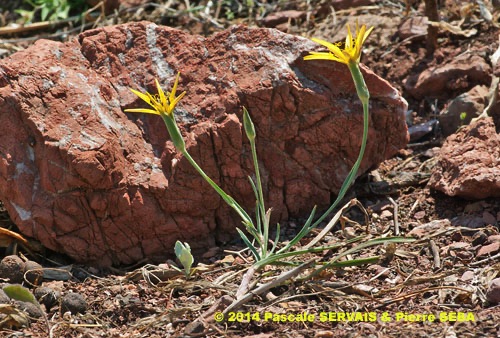
8
Photo 1 :
Localisation / Location : Tilos, Livadia, Village
Date : 15/05/2015
GPS : Lat. 36,40899° N / Long. 27,39250° E / Alt. 13 m
Type : Photographie numérique / Digital Photograph (10 mégapixels)
Photo 2 :
Localisation / Location : Tilos, Livadia, Gorges de Lethra
Date : 21/05/2014
GPS : Lat. 36,43073° N / Long. 27,38141° E / Alt. 111 m
Type : Photographie numérique / Digital Photograph (10 mégapixels)
Photo 3 :
Localisation / Location : Tilos, Livadia, Village
Date : 15/05/2015
GPS : Lat. 36,41072° N / Long. 27,38756° E / Alt. 9 m
Type : Photographie numérique / Digital Photograph (10 mégapixels)
Photo 4 :
Localisation / Location : Tilos, Livadia, Village
Date : 15/05/2015
GPS : Lat. 36,41072° N / Long. 27,38756° E / Alt. 9 m
Type : Photographie numérique / Digital Photograph (10 mégapixels)
Photo 5 :
Localisation / Location : Tilos, Livadia, Village
Date : 15/05/2015
GPS : Lat. 36,41072° N / Long. 27,38756° E / Alt. 9 m
Type : Photographie numérique / Digital Photograph (10 mégapixels)
Photo 6 :
Localisation / Location : Tilos, Livadia, Village
Date : 15/05/2015
GPS : Lat. 36,41072° N / Long. 27,38756° E / Alt. 9 m
Type : Photographie numérique / Digital Photograph (10 mégapixels)
Photo 7 :
Localisation / Location : Tilos, Livadia, Village
Date : 15/05/2015
GPS : Lat. 36,41072° N / Long. 27,38756° E / Alt. 9 m
Type : Photographie numérique / Digital Photograph (10 mégapixels)
Photo 8 :
Localisation / Location : Tilos, Livadia, Gorges de Lethra
Date : 21/05/2014
GPS : Lat. 36,43073° N / Long. 27,38141° E / Alt. 111 m
Type : Photographie numérique / Digital Photograph (10 mégapixels)

Google Maps
Google Maps
Google Maps
Google Maps
Google Maps
Google Maps
Google Maps
Google Maps